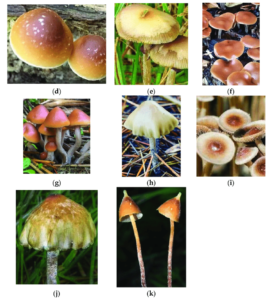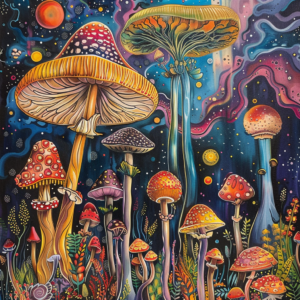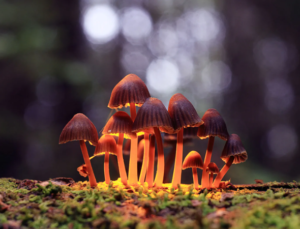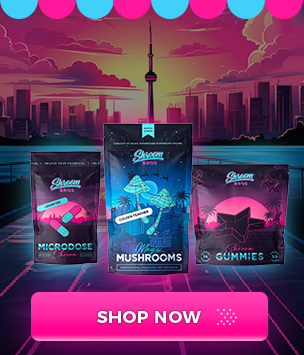Magic mushrooms, or psilocybin mushrooms, have captivated human imagination and spiritual practice for centuries. Found in various parts of the world, these fungi are sought after for their psychoactive properties, primarily due to compounds like psilocybin and psilocin. From ancient shamanic rituals to modern psychological research, the allure of magic mushrooms spans across cultures and epochs, hinting at the profound impact they’ve had on human consciousness and society.
This blog delves into the different kinds of magic mushrooms, exploring their types, effects, historical significance, and the ethical considerations surrounding their use and cultivation. By understanding the various species and their unique attributes, enthusiasts and researchers alike can appreciate the depth and breadth of these natural psychedelics’ impact on human culture and personal experience.
Stay tuned as we embark on this fascinating journey through the world of magic mushrooms, shedding light on their mystical properties and the ethical considerations of their cultivation and use.
Types of Magic Mushrooms
Magic mushrooms, revered for their potent psychoactive compounds, primarily psilocybin, encompass a variety of species, each with its unique characteristics and potency. This section explores some of the most notable types, offering insights into their appearance, habitat, and effects.
Psilocybe Cubensis
Often hailed as the most popular and widely recognized type of magic mushroom, Psilocybe cubensis is known for its relatively sizable golden caps and robust stems. Thriving in humid, tropical climates, this species is commonly found in the United States, Central and South America, Southeast Asia, and Australia. Its popularity is due in part to its ease of cultivation compared to other species, making it a favorite among home cultivators. The effects of Psilocybe cubensis can vary but typically include euphoria, profound introspection, visual alterations, and a sense of connectedness with the universe, lasting between 4 to 6 hours.
Psilocybe Semilanceata
Also known as the “Liberty Cap,” Psilocybe semilanceata is distinguished by its pointed cap. It’s primarily found in grassy fields across North America and Europe, especially those frequented by grazing animals. This species is noted for its strong potency, attributed to high levels of psilocybin. Individuals consuming Psilocybe semilanceata report intense visual hallucinations, enhanced emotional states, and spiritual experiences. Its effects are profound, with experiences lasting from 4 to 8 hours, depending on the dosage and individual sensitivity.
Psilocybe Cyanescens
Commonly referred to as “Wavy Caps” due to the distinctive undulating edges of their caps, Psilocybe cyanescens boasts a significant potency that can surpass that of Psilocybe cubensis. These mushrooms flourish in woody debris in urban and suburban areas, particularly along the West Coast of the United States and parts of Europe. Their effects include powerful visual distortions, deep philosophical insights, and a strong sense of oneness with nature, lasting anywhere from 4 to 6 hours.
Psilocybe Azurescens
Originating from the West Coast of the United States, Psilocybe azurescens is renowned for being one of the most potent magic mushrooms, containing high levels of psilocybin and psilocin. They typically grow in sandy soils, such as dunes along beaches or riverbanks. The experiences elicited by Psilocybe azurescens are intense and can include profound alterations in perception, extreme visual enhancements, and deep, introspective journeys. Due to their strength, they’re often sought after by experienced users seeking a more profound experience.
Other Notable Varieties
In addition to the species mentioned, the magic mushroom family includes numerous other varieties, each with its unique properties. These include Psilocybe baeocystis, known for its potent psychoactive effects; Psilocybe mexicana, famous for its use in traditional Mazatec rituals; and Psilocybe tampanensis, which is unique for producing psychoactive truffles, or “Philosopher’s Stones.” Each species offers a different experience, influenced by its psilocybin content, the individual’s mindset, and the setting in which they are consumed.
Effects of Magic Mushrooms
The allure of magic mushrooms largely stems from their profound psychoactive effects, which can vary widely depending on the species consumed, the dosage, and the individual’s mental state and environment. This section explores the psychological and physical effects commonly associated with magic mushroom use.
Psychological Effects
The psychological impact of magic mushrooms is both complex and variable, offering a spectrum of experiences that can range from enlightening to unsettling. Common psychological effects include:
- Enhanced Emotional Sensitivity: Users often report heightened emotions, experiencing everything from euphoria and profound joy to intense introspection and even sadness.
- Altered Perception of Time and Space: A common report among users is the distortion of time, where minutes can feel like hours, and spatial dimensions seem altered.
- Visual and Auditory Hallucinations: Vivid visual effects, such as enhanced colors, patterns, and shapes, are common, as are auditory hallucinations or changes in the way sounds are perceived.
- Spiritual Experiences and Insights: Many users describe feeling a deep connection to the universe, nature, or a higher power, often leading to new insights into personal or philosophical dilemmas.
- Ego Dissolution: At higher doses, users may experience a loss of self-identity or ego dissolution, leading to a sense of oneness with their surroundings or the universe.
Physical Effects
Alongside psychological changes, magic mushrooms can induce various physical effects, which typically include:
- Changes in Vital Signs: Users might experience changes in heart rate and blood pressure, which, while generally not harmful, can be unsettling.
- Nausea and Gastrointestinal Discomfort: Especially common at the onset of the experience, these symptoms can sometimes lead to vomiting.
- Pupil Dilation: A noticeable physical sign of psilocybin ingestion is the dilation of pupils, leading to increased sensitivity to light.
- Increased Energy or Lethargy: Depending on the individual and the type of mushroom, users may feel either energized or extremely relaxed and lethargic.
- Motor Coordination Issues: Some might find their coordination affected, leading to clumsiness or a sense of physical disorientation.
It’s important to note that the effects of magic mushrooms can be influenced by the “set and setting” — the user’s mindset and the physical and social environment in which they are consumed. Positive settings can enhance the experience, while negative ones can lead to discomfort or distress, emphasizing the need for careful planning and respect for the mushrooms’ power.
Cultural and Historical Use
The use of magic mushrooms spans across cultures and continents, reflecting a rich tapestry of spiritual and medicinal practices throughout history.
Indigenous Use
For thousands of years, indigenous cultures in Mesoamerica have revered psilocybin mushrooms as sacred tools for spiritual rituals and healing ceremonies. The Mazatecs, Mixtecs, Nahuas, and Zapotecs, among others, have used these mushrooms in divinatory practices, to communicate with deities, and to heal the sick. In these cultures, mushrooms were not merely drugs but sacred entities that provided wisdom, healing, and connection to the spiritual world.
Modern Psychedelic Culture
The modern Western interest in magic mushrooms surged in the 1950s and 60s, following the publication of R. Gordon Wasson’s article in Life magazine, which detailed his experiences participating in a Mazatec mushroom ceremony. This sparked a global psychedelic movement, influencing everything from psychiatric research to popular culture. The counterculture movement of the 1960s embraced psychedelics, including magic mushrooms, as tools for social, political, and spiritual awakening.
In recent years, there’s been a renaissance in psychedelic research, with studies exploring the potential of psilocybin to treat conditions like depression, anxiety, and PTSD. This renewed interest highlights the enduring fascination and respect for these natural compounds and their ability to alter human consciousness profoundly.
Cultivation and Ethical Considerations
The cultivation of magic mushrooms has gained popularity as interest in their psychoactive and potential therapeutic effects has increased. However, the cultivation, use, and distribution of these fungi come with significant ethical considerations, including respect for indigenous knowledge, conservation of natural habitats, and responsible use.
Overview of Cultivation Techniques
Cultivating magic mushrooms typically involves several stages, starting from spore inoculation to colonizing a substrate and finally fruiting, where mushrooms develop from the mycelium. The most common species cultivated at home, Psilocybe cubensis, is favored for its robustness and relatively straightforward growing requirements. Techniques vary from simple and low-tech, such as the PF Tek method, to more advanced methods involving sterilized grains and controlled environmental conditions.
While cultivation can make magic mushrooms more accessible for personal use or research, it raises questions about the commodification of naturally occurring psychedelics and the potential impact on wild mushroom populations.
Ethical Harvesting and Conservation Concerns
As the demand for magic mushrooms increases, so does the concern for the conservation of their natural habitats. Ethical harvesting practices are crucial to ensuring that wild populations of psychedelic mushrooms are not depleted. This includes taking only what is needed, being careful not to damage the mycelium, and leaving enough mushrooms to allow for spore dispersal to ensure future growth.
Moreover, the global interest in magic mushrooms has led to a deeper appreciation of the traditional knowledge and practices of indigenous peoples who have used these substances for centuries. Ethical considerations must include respect for these cultures and the acknowledgment of their ancestral knowledge regarding psychedelic plants and fungi. This involves not only giving credit where it is due but also supporting initiatives that protect indigenous rights and promote the sustainable use of natural resources.
Responsible Use
The potent effects of magic mushrooms necessitate a responsible approach to their use. This includes understanding the potential risks and benefits, considering the set and setting, and being aware of one’s mental health and wellbeing. The movement towards decriminalization and medical research underscores the importance of informed, respectful, and safe use of psychedelics.
Advocacy for responsible use also involves educating the public about the potential therapeutic benefits of psilocybin and other psychedelics while emphasizing the need for guided experiences, especially for individuals dealing with mental health issues. The integration of traditional wisdom with modern therapeutic practices can offer a holistic approach to the healing potential of magic mushrooms.
Conclusion
The world of magic mushrooms is vast and complex, encompassing a wide range of species with various effects and significant cultural and historical importance. Understanding the different types of magic mushrooms, their effects, and the cultural contexts in which they are used opens up a rich tapestry of human experience and knowledge.
As we explore the potential of these natural psychedelics, whether through personal experiences, scientific research, or cultural engagement, it’s crucial to approach them with respect and awareness. This includes considering the ethical implications of their cultivation and use, the conservation of natural habitats, and the respect for indigenous knowledge and practices.
Magic mushrooms hold the promise of profound insights and healing, but they also require us to confront questions about our relationship with nature, consciousness, and each other. By navigating these questions with care and respect, we can better appreciate the gift of these remarkable fungi and their potential to enrich our understanding of the mind and the natural world.















